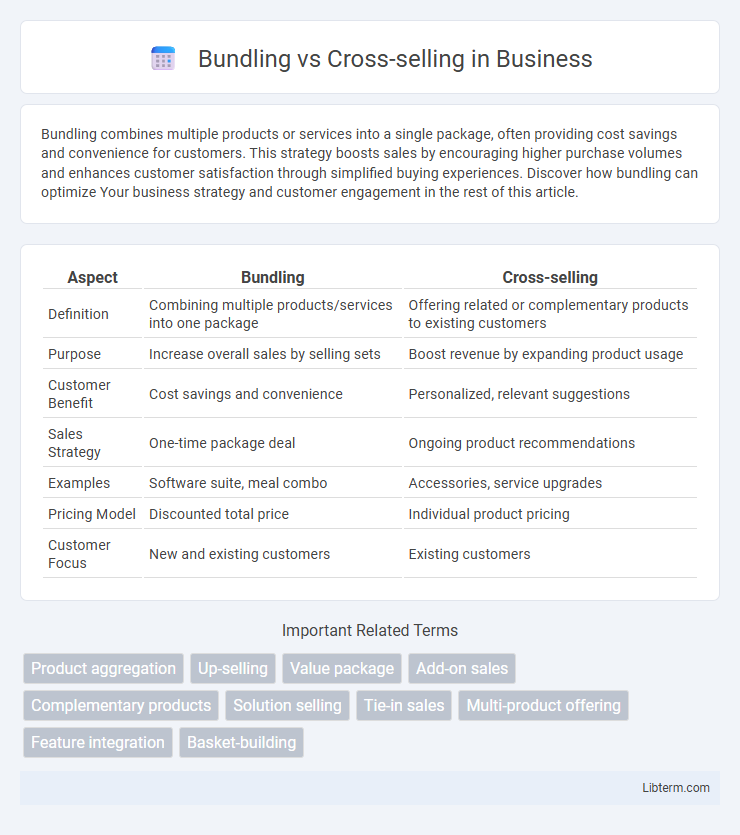Bundling combines multiple products or services into a single package, often providing cost savings and convenience for customers. This strategy boosts sales by encouraging higher purchase volumes and enhances customer satisfaction through simplified buying experiences. Discover how bundling can optimize Your business strategy and customer engagement in the rest of this article.
Table of Comparison
| Aspect | Bundling | Cross-selling |
|---|---|---|
| Definition | Combining multiple products/services into one package | Offering related or complementary products to existing customers |
| Purpose | Increase overall sales by selling sets | Boost revenue by expanding product usage |
| Customer Benefit | Cost savings and convenience | Personalized, relevant suggestions |
| Sales Strategy | One-time package deal | Ongoing product recommendations |
| Examples | Software suite, meal combo | Accessories, service upgrades |
| Pricing Model | Discounted total price | Individual product pricing |
| Customer Focus | New and existing customers | Existing customers |
Introduction to Bundling and Cross-selling
Bundling combines multiple products or services into a single package, offering customers convenience and perceived value while enabling businesses to increase sales volume and optimize inventory. Cross-selling involves suggesting complementary or related products during or after a purchase to enhance customer experience and boost average transaction size. Both strategies leverage consumer behavior insights to maximize revenue, though bundling emphasizes package deals and cross-selling focuses on individualized product recommendations.
Definitions: What is Bundling?
Bundling is a marketing strategy where multiple products or services are combined and sold as a single package, often at a discounted price compared to purchasing each item separately. This approach increases perceived value, encourages higher sales volume, and simplifies the buying decision for customers. Common examples include software suites, meal deals, and telecommunications packages that integrate internet, phone, and TV services.
Definitions: What is Cross-selling?
Cross-selling is a sales technique where a business encourages customers to purchase additional, complementary products or services related to their original purchase. This strategy aims to increase the overall transaction value by offering relevant items that enhance the primary product's functionality or customer experience. Common examples include suggesting accessories with electronics or extended warranties during checkout.
Key Differences Between Bundling and Cross-selling
Bundling involves offering multiple products or services together as a single combined package, often at a discounted price to increase perceived value and simplify purchase decisions. Cross-selling refers to promoting complementary or related products individually during or after the initial sale, aiming to enhance customer satisfaction and increase overall sales revenue. The key difference lies in bundling's emphasis on packaging items to create a new buying option, while cross-selling focuses on suggesting additional products to augment the original purchase.
Benefits of Bundling Strategies
Bundling strategies increase customer perceived value by offering multiple products or services together at a reduced price, encouraging higher purchase volumes and boosting overall sales revenue. This approach simplifies the buying decision, enhances customer satisfaction through convenience, and reduces marketing and transaction costs for businesses. Bundling also helps in clearing slow-moving inventory and improves customer retention by creating a comprehensive product ecosystem that meets diverse needs.
Advantages of Cross-selling Techniques
Cross-selling techniques increase customer lifetime value by encouraging buyers to purchase complementary products, enhancing overall sales revenue. These methods improve customer satisfaction through personalized recommendations that meet specific needs, fostering brand loyalty. Implementing effective cross-selling strategies also optimizes inventory turnover by promoting less popular items alongside high-demand products.
Use Cases: When to Use Bundling vs Cross-selling
Bundling is ideal for increasing average order value by combining complementary products, such as a smartphone with earbuds and a protective case, appealing to customers seeking convenience and savings. Cross-selling works best during the checkout process by recommending related or upgraded products, like suggesting a higher-capacity memory card when a customer buys a camera. Use bundling to create value packages that drive volume sales, and deploy cross-selling to enhance individual product purchases and improve customer experience.
Impact on Customer Experience and Satisfaction
Bundling simplifies the purchasing process by offering customers a curated package of complementary products, often providing better value and convenience that enhance overall satisfaction. Cross-selling introduces customers to related or supplementary items during the buying journey, potentially increasing perceived product relevance and personalized experience but risks overwhelming if not skillfully managed. Both strategies, when executed with customer-centric communication and relevance, significantly influence positive customer experience and foster long-term loyalty.
Common Mistakes to Avoid in Bundling and Cross-selling
Common mistakes in bundling include offering unrelated products that confuse customers and failing to provide clear value, which reduces purchase motivation. In cross-selling, pushing irrelevant or low-quality add-ons can damage trust and lead to customer frustration. Avoiding these errors by aligning product combinations with customer needs and preferences enhances satisfaction and boosts sales effectiveness.
Best Practices for Implementing Bundling and Cross-selling
Effective bundling and cross-selling strategies enhance customer value and increase average transaction size by carefully analyzing customer preferences and purchase patterns. Best practices include offering complementary products with clear price incentives, personalizing recommendations based on customer data, and ensuring seamless integration within the buying process to avoid overwhelming the shopper. Businesses like Amazon and Starbucks excel by using dynamic algorithms and curated bundles, maximizing relevance and customer satisfaction.
Bundling Infographic

 libterm.com
libterm.com